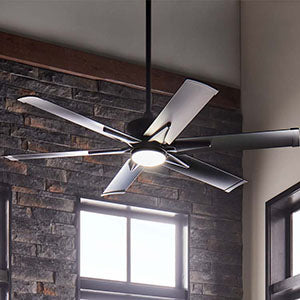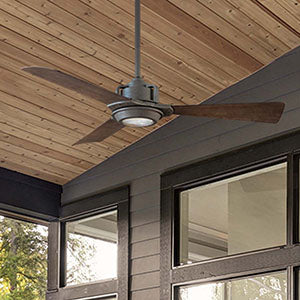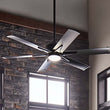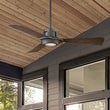The Essential Ceiling Fan Guide: Need-To-Know Style, Size, and Placement Tips
Ceiling fans are style and function superstars in any home. They circulate air so you feel cooler when it's hot, and they warm up a room fast when it's cold outside—all while delivering panache to your home.

But the best ceiling fan styles and room placement varies depending on the dimensions of the space. The size of the blades will also impact airflow and efficiency. And, of course, you'll want to select a fan style that matches your home décor. Read on for must-know tips on ceiling fan types, blade sizing, and proper placement. Then kick back and enjoy the breeze.
Types of Ceiling Fans
Standard ceiling fans
These fans are what you'd picture if someone said, "imagine a ceiling fan." They showcase five blades, a pull chain, and hang from the ceiling on a vertical downrod. They come with reversible blades, and you can find them in a diverse assortment of colors, finishes, and styles ranging from farmhouse to traditional to contemporary.
Low-profile or flush mount ceiling fans
Instead of hanging from a downrod, these fans attach directly to a mounting bracket bringing them closer to the ceiling. They are the ideal choice for smaller rooms and spaces with low ceilings, blending exceptional cooling ability with engaging designs.
Enclosed ceiling fans
These innovative fixtures—often called 'fandeliers'—have blades and lighting inside a canopy. You can install this style fan indoors, but they are especially suited for use in outdoor spaces, such as a porch or pagoda.
Ceiling fans with lights
These fans come in a wide variety of styles, but include light fixtures. They are a great overhead lighting choice, because they serve a dual purpose.
Outdoor patio fans
Designed for outdoor use, patio fans feature housings and blades made from materials that resist deterioration from moisture or humidity. When buying these fans, be sure to check for 'damp' or 'wet' ratings to see what level of moisture they can withstand. Outdoor fans move air on muggy days and even keep bugs at bay, making outdoor living spaces more inviting in the heat.
Ceiling Fan Style Inspiration
Beyond types, ceiling fans come in a variety of showstopping design styles. Learn your design style, and then choose ceiling fans that match your style and complement your home. To inspire your search for the perfect ceiling fan, here are a handful of styles to consider:

Windmill ceiling fans. This fan style has a distinctly rustic vibe reminiscent of its namesake. You can find styles with 10 blades and more.

Modern and contemporary ceiling fans. Sleek lines, metallic finishes, and simplicity define modern ceiling fans.

Traditional ceiling fans. Deliver a touch of homespun appeal to any room with classic fans. They often double as ceiling lights and showcase intricate metalwork where the blades attach to the motor casing.

Wood and metal ceiling fans. Mixed materials combine for uniquely beautiful fixtures that can showcase rustic, retro, or futuristic style.
Ceiling Fan Blade Sizes and Angles
Once you've chosen your ceiling fan style, it's time to shift your focus to the number, size, and angle of the blades. These variables impact the overall look of the fan, as well as its power and efficiency.
How Many Blades Should a Ceiling Fan Have?
Aesthetically, the correct number of blades in a ceiling fan depends purely on your personal taste. Sculptural, 3-blade fans have a modern aesthetic, where fans with a dozen or more weathered wooden blades offer shabby chic charm.
But you may well wonder if 3-blade or 4-blade ceiling fans are better? What about 5-blade fans? Or 10?
Performance-wise, higher numbers of blades tend to produce more drag, which can result in a somewhat slower fan and even slightly lower air circulation. However, today's ceiling fans are energy-efficient and produce enough air circulation. Most ceiling fans also come with multiple RPM settings, so you can find the speed that works best for you.
The takeaway? If you fall in love with a particular style, you can feel confident it'll provide the airflow you need—so long as you select the right size.
How Do You Determine Ceiling Fan Size?
Common sense dictates that a ceiling fan for a small kitchen should be smaller than one for a large living room. To pick the right ceiling fan width, you will have to match its blade span—measured from the tip of one blade to the tip of another across from it—with its ideal room size. Standard suggested blade lengths for various spaces:

Up to 75 square feet: 29" to 36" blades
From 76 to 175 square feet: 42" to 48" blades
From 176 to 350 square feet: 52" to 58" blades
More than 350 square feet: 60" and up
How Blade Pitch Affects Airflow
The steeper the blade pitch (or angle), the more the fan moves the air. A steep blade pitch also means the fan requires a more powerful motor, because there's more drag and it has to work harder. Lower blade pitches are flatter, and don't move quite much air. Typically, ceiling fan blade pitches run between 12 to 15 degrees, though you can find outliers.
What does this mean for your decision-making? Again, it comes down to your preference and room size. If you like a fan that produces the equivalent of a gentle breeze, opt for a pitch of 12 or 13 degrees. If you're circulating air through a larger space with a high ceiling, a steep blade pitch of 14 to 15 degrees is the better choice.
Ceiling Fan Placement
How far does a ceiling fan have to be from a wall?
Ceiling fans must be a minimum of 18 inches away from any walls, cabinets, lights, doors, or other tall room elements.
In most instances, the exact center of the room is the ideal location for a ceiling fan. However, some room shapes require a mix of creativity and common sense. For example, the best ceiling fan location for an L-shaped room may be where the two wings come together. In a great room, you may choose to place the fan over the side of the room where there's more seating.
How far should a fan hang from a ceiling?
The minimum distance between your fan blades and the ceiling should be 8 inches, with 10 to 12 inches producing the ideal airflow. If you are hanging a fan on a vaulted or sloped ceiling, be sure to use a downrod long enough so that the blades spin freely.

How high should a ceiling fan be above the floor?
Make sure the bottom of your ceiling fan is at least 7 feet above the floor to avoid head bonks and injuries.
Ceiling Fan Mounting Considerations
When determining placement, you must also factor in your choice of a downrod (a vertical arm between the ceiling mount and fan) or a flush-mount (sits close to the ceiling).
Determine the right downrod length for the space
A ceiling fan must be low enough to create good airflow and high enough to provide ample head clearance. If the downrod is too long or too short for the space, you can get a replacement downrod to adjust the fan to the right height. (Be sure to match brands when purchasing replacement downrods.) Here are the recommended downrod lengths for different ceiling heights:
9-foot ceiling: 6-inch downrod
10-foot ceiling: 12-inch downrod
11-foot ceiling: 18-inch downrod
12-foot ceiling: 24-inch downrod
13-foot ceiling: 36-inch downrod
14-foot ceiling: 48-inch downrod
15-foot ceiling: 60-inch downrod
Use flush-mount fans for low ceilings
If your ceiling is only 8' high, you should not use a ceiling fan with a downrod. Flush mount (or 'hugger') ceiling fans are designed to ensure proper airflow and headroom. Most models include vented motors, which prevents overheating even though they are close to the ceiling.
Keeping It Cool and In Control
Beyond pull chains, you can control ceiling fans via wall switches with dimmers and speed controls, or you can go the remote control route.
- Wall switch: Easily installed just like adding a light switch, wall switches control the power, fan speed, and brightness.
- Remote control: Keep the fan controller close by on a coffee table or nightstand for easy adjustments.
- Combo: Enjoy the accessibility of a remote, with a wall-mounted backup in case you misplace the remote.
Ceiling Fan Direction in Winter
Finally, use your switch or remote to change the direction of your ceiling fan to clockwise in winter. In the warm months, your fan should spin counterclockwise, which pushes the air downward to create a cooling effect. But in winter, the blades should rotate clockwise, which draws air up and circulates warmer air near the ceiling throughout the space.
When you select the right ceiling fan, you improve the aesthetics of any living space and move the air so that you and your guests are comfortable year round.



















